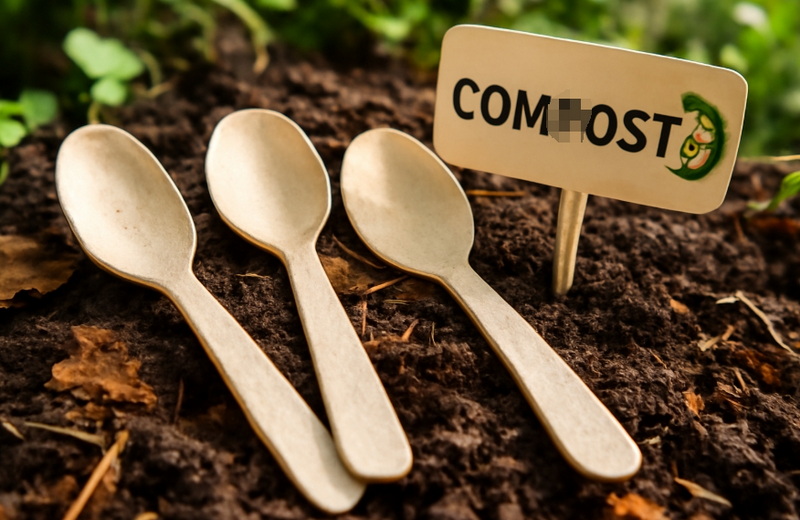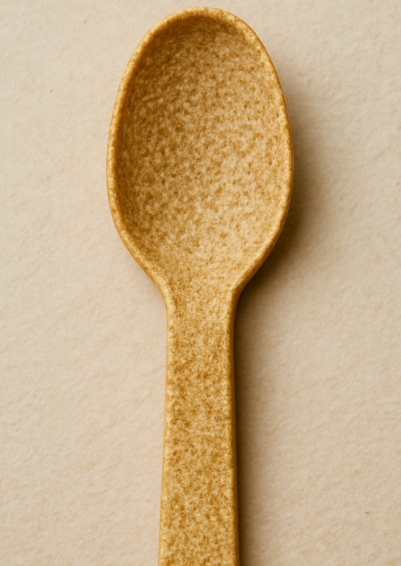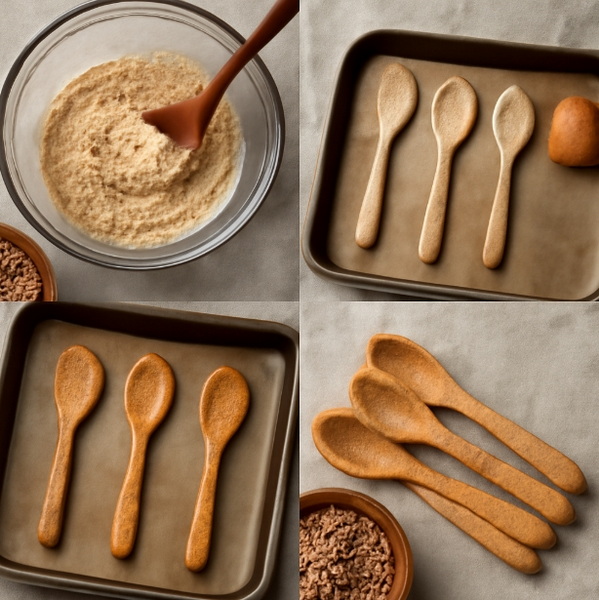
Content Menu
● Why Make a Disposable Spoon From Wheat?
>> Environmental Impact
>> Health and Safety
>> Versatility and Customization
● The Science Behind Wheat-Based Disposable Spoons
● Step-by-Step Guide: How to Make a Disposable Spoon From Wheat
>> Ingredients
>> Equipment
>> Preparation Steps
>>> 1. Prepare the Dough
>>> 2. Rest and Knead
>>> 3. Shape the Spoons
>>> 4. Bake
>>> 5. Cool and Store
● Tips for Success
● The Benefits of Making a Disposable Spoon From Wheat
>> Sustainability
>> Economic Opportunities
>> Health and Safety
>> Versatility
● Commercial Production: Scaling Up
● Conclusion
● Frequently Asked Questions (FAQ)
>> 1. How strong are wheat-based disposable spoons?
>> 2. Are wheat spoons safe for people with gluten intolerance?
>> 3. How long does it take for a wheat-based spoon to decompose?
>> 4. Can I flavor or color my wheat spoons?
>> 5. How should I store homemade wheat spoons?
Plastic pollution is a pressing environmental issue, with single-use plastic cutlery being a significant contributor to landfills and ocean waste. As society becomes more eco-conscious, the demand for sustainable alternatives continues to rise. Among these, the innovative idea to make a disposable spoon from wheat stands out for its practicality, sustainability, and even its edible potential. Imagine enjoying your meal and then either eating your spoon or composting it guilt-free. This comprehensive article will guide you through the science, benefits, and step-by-step process to make a disposable spoon from wheat, empowering you to create your own eco-friendly cutlery at home.
For a hands-on demonstration, you can watch a video tutorial on making edible wheat spoons, which visually walks through each stage of the process.

Why Make a Disposable Spoon From Wheat?
Environmental Impact
Traditional plastic spoons persist in the environment for centuries, contributing to microplastic pollution and harming wildlife. In contrast, when you make a disposable spoon from wheat, you use a renewable resource that is fully biodegradable and compostable. Wheat spoons decompose quickly, leaving no lasting trace.
Health and Safety
Wheat-based spoons are crafted from natural, food-grade ingredients, free from the toxins and microplastics found in plastic cutlery. This makes them a safer choice for both consumers and the environment.
Versatility and Customization
The process to make a disposable spoon from wheat allows for customization in flavor, texture, and dietary requirements. Whether you prefer a sweet, savory, or neutral taste, the base dough can be adjusted to suit your preferences.
The Science Behind Wheat-Based Disposable Spoons
Wheat flour contains gluten, a protein that provides elasticity and structure, making it ideal for forming sturdy, moldable dough. When baked, the dough hardens, resulting in a functional and edible spoon. The addition of other grains or fibers, such as rice or sorghum, can further enhance the spoon's strength and flavor.
Another method involves using wheat straw, the fibrous byproduct left after harvesting wheat grains. The straw is processed to extract cellulose and lignin, which are then combined with natural polymers and molded into cutlery. This approach yields biodegradable utensils that mimic the durability of plastic but break down naturally after use.
Step-by-Step Guide: How to Make a Disposable Spoon From Wheat
Ingredients
- Whole wheat flour (or a blend of wheat, rice, and sorghum flours)
- Salt
- Oil (such as sunflower or olive oil)
- Water
- Optional: sugar (for sweet spoons), herbs or spices (for savory spoons)
Equipment
- Mixing bowl
- Rolling pin
- Spoon molds or metal spoons
- Baking tray
- Oven
Preparation Steps
1. Prepare the Dough
Begin by combining wheat flour with a pinch of salt in a large bowl. For sweet spoons, add sugar; for savory spoons, mix in your favorite herbs or spices. Add oil to the dry ingredients, then gradually incorporate water while mixing until a stiff, non-sticky dough forms. The dough should be firm enough to hold its shape but pliable for molding.
2. Rest and Knead
Cover the dough and let it rest for about half an hour. This resting period allows the gluten to relax, making the dough easier to work with. After resting, knead the dough again to ensure it is smooth and uniform.
3. Shape the Spoons
Roll out the dough to a thickness of about five millimeters. Use a real spoon or a spoon-shaped cutter as a template to cut out spoon shapes from the dough. Press these shapes onto the convex side of a greased metal spoon or into a silicone spoon mold. This step helps the spoons retain their shape during baking.
4. Bake
Preheat your oven to a moderate temperature. Arrange the molded dough spoons on a baking tray. Bake them for about fifteen to twenty-five minutes, or until they become golden brown and firm. The exact baking time may vary depending on your oven and the thickness of the spoons.
5. Cool and Store
After baking, allow the spoons to cool completely in the molds to prevent warping. Once cool, gently remove the spoons from the molds. Store them in an airtight container to maintain their crispness and prevent them from absorbing moisture.
Tips for Success
- Ensure the dough is stiff; a soft dough will result in fragile spoons.
- For extra strength, use a blend of wheat, rice, and sorghum flours.
- Roll the dough evenly to ensure consistent baking and texture.
- Experiment with different flavors to match your meal, such as cocoa for desserts or herbs for soups.
- If you don't have molds, the back of a metal spoon can serve as a simple form.

The Benefits of Making a Disposable Spoon From Wheat
Sustainability
Choosing to make a disposable spoon from wheat supports a circular economy. These spoons are biodegradable, compostable, and made from renewable resources, drastically reducing landfill waste and environmental pollution compared to plastic alternatives.
Economic Opportunities
Wheat-based cutlery can create new revenue streams for farmers and manufacturers by utilizing wheat byproducts, such as wheat straw, that might otherwise be discarded or burned.
Health and Safety
Wheat spoons contain no harmful chemicals and are generally safe for most people, except those with gluten sensitivities. They can be fortified with additional nutrients for enhanced health benefits.
Versatility
These spoons are suitable for both hot and cold foods and can be flavored to complement any dish. After use, they can be eaten or composted, leaving no waste behind.
Commercial Production: Scaling Up
On a larger scale, the process involves mixing wheat and other flours, kneading the dough, rolling and molding it into spoons, and then baking at high temperatures for a short period. Automated systems use conveyor belts and molds to mass-produce uniform, durable spoons. The finished spoons are packaged for sale and can have a shelf life of up to a year when stored properly.
Conclusion
Learning how to make a disposable spoon from wheat is more than a creative kitchen project—it is a meaningful step toward reducing plastic waste and embracing sustainable living. Wheat-based spoons are sturdy, versatile, and fully biodegradable. Whether you are an eco-conscious individual, a food business owner, or someone who enjoys innovative DIY projects, making your own wheat spoons is both rewarding and impactful. With simple ingredients and basic kitchen tools, you can create cutlery that is safe, customizable, and environmentally friendly.
By choosing to make a disposable spoon from wheat, you are contributing to a cleaner planet and inspiring others to rethink their everyday choices. The next time you need a spoon, consider making one from wheat—your meal and the Earth will thank you.

Frequently Asked Questions (FAQ)
1. How strong are wheat-based disposable spoons?
Wheat-based disposable spoons are quite sturdy and can handle most foods, including soups and desserts. Their strength depends on the thickness and baking time. For the best results, use a blend of wheat and other grains and ensure the dough is rolled evenly before baking.
2. Are wheat spoons safe for people with gluten intolerance?
Wheat spoons contain gluten and are not suitable for individuals with celiac disease or gluten intolerance. However, alternative recipes using gluten-free flours like rice or millet are available, but always check the ingredients before consuming.
3. How long does it take for a wheat-based spoon to decompose?
A wheat-based disposable spoon typically decomposes within a few weeks in a home compost and even faster in commercial composting facilities. Unlike plastic, which can persist for centuries, wheat spoons break down naturally and enrich the soil.
4. Can I flavor or color my wheat spoons?
Absolutely. You can add herbs, spices, cocoa, or natural food coloring to the dough to create flavored or colored spoons. This customization allows you to match the spoons to your meal or add a creative touch for special occasions.
5. How should I store homemade wheat spoons?
Store your homemade wheat spoons in an airtight container in a cool, dry place. This prevents them from absorbing moisture and becoming soft. For extended shelf life, you can refrigerate them, especially in humid climates.

















